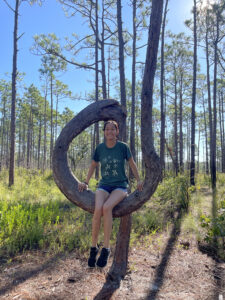
In August, the Paerl lab welcomed its newest research technician Lindsay Yue! Lindsay received her B.A. from Amherst College in Biology in 2021. She will be taking over our CHN and fluorometric chlorophyll a analyses. Welcome to the team, Lindsay!

In August, the Paerl lab welcomed its newest research technician Lindsay Yue! Lindsay received her B.A. from Amherst College in Biology in 2021. She will be taking over our CHN and fluorometric chlorophyll a analyses. Welcome to the team, Lindsay!
The Paerl Lab partners with Renzun Zhao, PhD, at North Carolina Agricultural and Technical State University as part of an Environmental Enhancement Grant (EEG) for several nutrient addition bioassay experiments each year. The research explores how dissolved organic nitrogen (DON) found in liquid waste generated from landfills might impact water sources in the eastern part of the state. Christopher Osburn, PhD, at North Carolina State University also collaborates with the Paerl Lab as part of this project.
Yesterday, the team set up the second bioassay experiment of this project for 2023! We are specifically looking at the effects of “aged effluent” compared to fresh effluent on water from the Neuse River Estuary. Effluent is liquid waste or sewage that is discharged into a body of water. We will keep you updated throughout the experiment!
Hi all,
I hope everyone is enjoying the start of summer. River flow over the month prior to the 11 May 2023 sampling trip was about twice the seasonal norm. The tip of the salt wedge was near New Bern and the lower estuary is still saltier than normal at a salinity of ~20. Strong salinity based stratification was reinforced by temperature gradients with bottom water temperature 2-4 degrees cooler than the surface. Bottom water dissolved oxygen was 4-6 mg/L along most of the transect but dipped to near hypoxic (<2 mg/L) near the tip of the salt wedge at stations 30 and 50. Chlorophyll was less than 10 ug/L throughout the estuary and only approached 10 ug/L within a broad mid-estuary maximum between stations 60 and 140. High river flows caused elevated turbidity (~10 NTU) in the river water entering the estuary.
Best,
Nathan
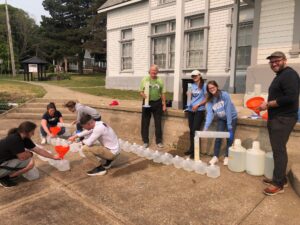
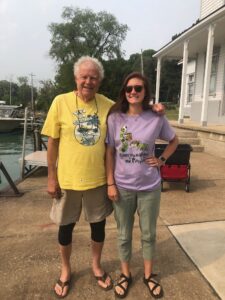
Members of the Paerl Lab, including Hans, Haley, Jack, Caroline and Elizabeth, are in Lake Erie this week, and the first bioassay experiment is in full swing! As you can see, we had a lot of help, including Chris Ward and his students from Bowling Green State University. Justin Chaffin set up the flow-through filtration system to provide <2 um filtered lake water. It would have taken us 2 days to filter that amount of lake water. Quite impressive! Thanks to everyone for all your help!
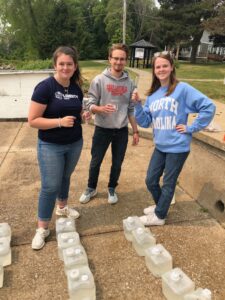
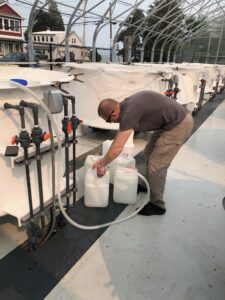
This week the Paerl Lab is busy at Lake Erie in Put-In-Bay, Ohio as part of a research project called the Lake Erie Center for the Great Lakes and Human Health Project supported by the National Institutes of Health (NIH) and the National Science Foundation (NSF). The Paerl Lab partners with Justin Chaffin of the F. T. Stone Laboratory at the Ohio State University as well as Chris Ward who is a professor at Bowling Green State University, and his students.
Hans Paerl, Haley Plaas, Jack Cheshire, Elizabeth Norris, and Caroline Lorio are there to collect samples and conduct a bioassay. Pictured here are Hans and Jack collecting water samples for the experiment beginning later today! A huge thank you to all of our scientific collaborators who make this research possible!
The Paerl Lab is back in the Bay Delta, CA this week, and the 2023 California Bioassay is well underway!
Haley Plaas and Leah Nelson are working to continue Haley’s dissertation research which focuses on assessing the linkage between nutrient enrichment, phytoplankton community composition, cyanobacterial harmful algal bloom toxin production, and aerosol formation in the San Francisco Bay Delta Estuarine ecosystem. This research has been accomplished by completing a combination of aerosol measurements and nutrient addition bioassay experiments.
Despite a few minor hiccups, everything is going great. Haley and Leah have had lots of help from our awesome interns, Cheyenne and Deborah!
The aerosol samplers are all up and running now at both Discovery Bay and Stockton and the bioassay experiment will be completed tomorrow. We look forward to seeing the results from both the bioassay and aerosol samples! We will be sure to keep you updated as we analyze the data in the weeks to come.
Thanks for all your help, Cheyenne and Deborah, as well as to all of our collaborators at CA-DWR, USGS, and Restore the Delta (and more)!
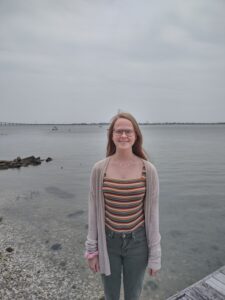
The Paerl Lab welcomes another new intern, Caroline Lorio, this week! There will be lots of new faces around the lab this summer. Caroline is currently pursuing her undergraduate degree in Biology and Environmental Science at UNC – Chapel Hill. We are so excited to work with you!
Hi all,
The winter and early spring saw flows that were always below normal and usually only about half of the seasonal norm. That changed starting on 10 April when flows began to rapidly increase. By the time of sampling 19 April, flows peaked at nearly twice the seasonal norm. Dumping that much freshwater into a really salty estuary caused very strong salinity based stratification with surface to bottom salinity differences of ~15 in the upper estuary from station 30 to station 120 and ~10 further downstream. Bottom waters were cool (< 15 C) and certainly the low temperatures helped prevent bottom water hypoxia. High turbidity (>10 NTU) flood water penetrated downstream to station 60 and turbidity was < 5 NTU throughout the rest of the estuary. A large mid-estuary chlorophyll maximum (> 20 ug/L) was observed from station 60 to 140 and was concentrated vertically just above the pycnocline at ~1.5 m depth. Microscopic examination of station 100 surface water revealed that small solitary centric diatoms and chain-forming centric diatoms were the dominant taxa. There was a relatively high concentration (~1000 cells/mL) of the toxic dinoflagellate, Karlodinium veneficum. Although 1000 cells/mL is higher than normal, Karlodinium doesn’t usually cause fish kills until the concentrations reach about 10,000 cells/mL.
-Nathan
© 2024 The Paerl Lab
Theme by Anders Noren — Up ↑